| Ambassador of Italy to Argentina | |
|---|---|
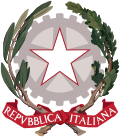 Emblem of Italy | |
| Inaugural holder | Marcello Cerruti |
| Formation | May 5, 1856 |
The Italian ambassador in Buenos Aires is the official representative of the Government in Rome to the Government of Argentina.
| Ambassador of Italy to Argentina | |
|---|---|
 Emblem of Italy | |
| Inaugural holder | Marcello Cerruti |
| Formation | May 5, 1856 |
The Italian ambassador in Buenos Aires is the official representative of the Government in Rome to the Government of Argentina.
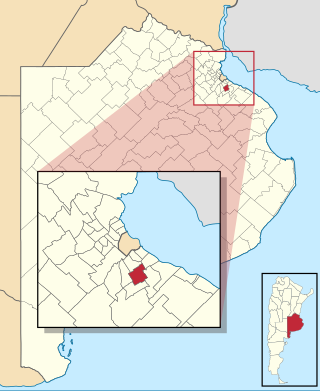
Almirante Brown is a partido of the Buenos Aires Province, Argentina, located at the south of the Gran Buenos Aires urban area, at coordinates 34°47′S58°24′W.

Belgrano is a northern and leafy barrio or neighborhood of Buenos Aires, Argentina.

The Congress of the Argentine Nation is the legislative branch of the government of Argentina. Its composition is bicameral, constituted by a 72-seat Senate and a 257-seat Chamber of Deputies. The Senate, whose members are elected to six-year terms renewable by thirds each two years, consists of three representatives from each province and the federal capital. The Chamber of Deputies, whose members are elected to four-year terms, is apportioned according to population, and renews their members by a half each two years.
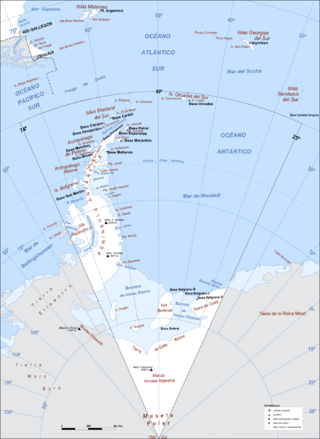

San Martín Palace is located facing Plaza San Martín in the Retiro neighbourhood of Buenos Aires, Argentina and serves as the Ceremonial Headquarters for the Ministry of Foreign Relations.

The Argentine National Historical Museum is located in Buenos Aires, Argentina, and is a museum dedicated to the history of Argentina, exhibiting objects relating to the May Revolution and the Argentine War of Independence.

Parque Patricios is a barrio located on the southern side of Buenos Aires, Argentina belonging to the fourth comuna.

Ciudadela is a city in Greater Buenos Aires, Buenos Aires Province, Argentina. It is located in the Tres de Febrero Partido, immediately to the west of the neighborhood of Liniers in Buenos Aires city proper. It is separated from the city by General Paz avenue.

The Campo Argentino del Polo, popularly known as The Cathedral of Polo, is a multi-purpose stadium in Buenos Aires, Argentina. It is currently used mostly for polo, pato and field hockey matches.

Plaza San Martín is a park located in the Retiro neighbourhood of Buenos Aires, Argentina. Situated at the northern end of pedestrianized Florida Street, the park is bounded by Libertador Ave. (N), Maipú St. (W), Santa Fe Avenue (S), and Leandro Alem Av. (E). Its coordinates are 34°35′42″S58°22′32″W.

The Ministry of Economy of Argentina is the country's state treasury and a ministry of the national executive power that manages economic policy.

Avenida Scalabrini Ortiz is an avenue that runs through Villa Crespo and Palermo neighborhoods of Buenos Aires, Argentina, and goes from southwest to northeast, parallel Avenida Juan B. Justo. It starts at Avenida Warnes, and ends at Avenida Figueroa Alcorta.

The National Center of High Performance Athletics is the sports complex where most Argentine sportspeople who compete internationally are trained.

The Islamic Cultural Center "Custodian of the Two Holy Mosques King Fahd in Argentina" is a mosque and center for Islamic culture located in Buenos Aires, Argentina. It is named after King Fahd of Saudi Arabia.
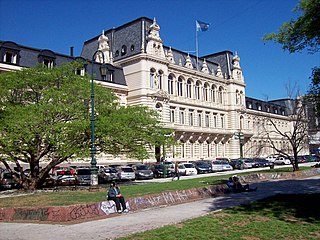
The Sarmiento Palace, commonly known as the Pizzurno Palace, is an architectural landmark in the Recoleta section of Buenos Aires and the location of the Argentine Ministry of Education.

Patio Bullrich is a shopping center located in the Retiro neighborhood of Buenos Aires, Argentina. The building was originally an auction house owned by the Bullrich family, where cattle and pieces of art were auctioned. The then-disused house was refurbished by Grupo IRSA, preserving its original architecture and elements. Under the name "Patio Bullrich", the mall was inaugurated in August 1988.

The Buenos Aires Customs House (Aduana) is a government building and architectural landmark in the Montserrat section of Buenos Aires.

The Equestrian monument to General Manuel Belgrano is a landmark of Buenos Aires, Argentina. It is located at Plaza de Mayo, in front of the Casa Rosada. It depicts General Manuel Belgrano holding the Flag of Argentina, and it is made of bronze over a pedestal of granite.
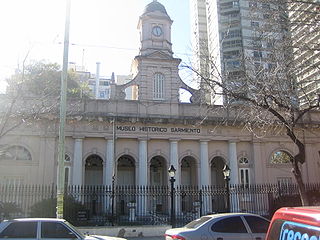
The Sarmiento History Museum, located in the Buenos Aires neighborhood of Belgrano, is a museum dedicated to Argentine history, and in particular to the Generation of '80 and the life of President Domingo Faustino Sarmiento, a writer and political figure who was President of Argentina between 1868 and 1874. There are also sections that show the literary works of Nicolás Avellaneda, his presidential successor and about the revolution caused by the federalization of Buenos Aires in 1880, when the national government had to abandon its location in downtown Buenos Aires and move to the building where the museum is today in Belgrano, then the outskirts of the city.

The Federal Intelligence Agency mostly known for its abbreviation AFI, is the principal intelligence agency of Argentina.